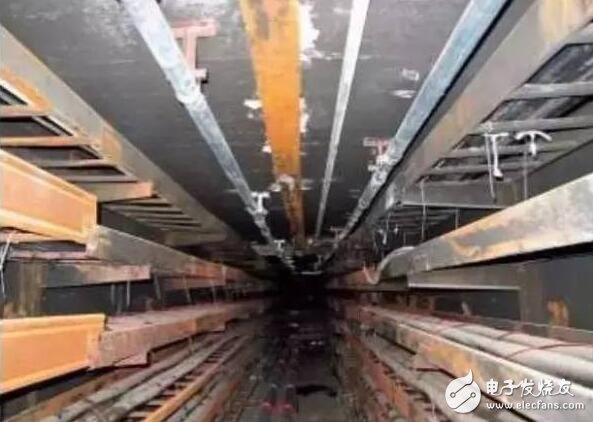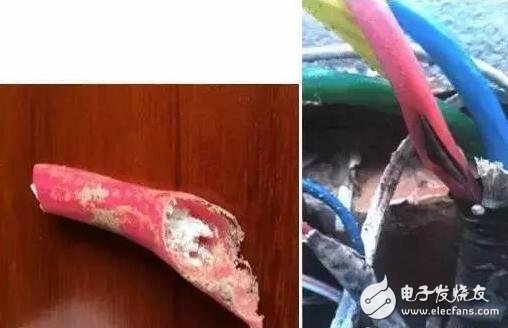Why can’t we choose aluminium alloy cable for Solar power cable?
Aluminum alloy cables have not been used for a long time in our country, but there are already cases that show that there are huge hidden dangers and risks in the application of aluminum alloy cables in cities, factories and mines. The following two practical cases and eight factors leading to the risk accidents of aluminum alloy cables are discussed.
Case 1
Aluminum alloy cables were used in batches in a steel plant. Two fires occurred in one year, resulting in a half-month shutdown and a direct economic loss of 200 million yuan.
This is a cable bridge which has been repaired after the fire. The traces of the fire are still striking.
Case two
Aluminum alloy cables are used in the lighting distribution system of a city in Hunan Province. Within one year after installation, strong corrosion of aluminum alloy cables occurred, resulting in damage of cable joints and conductors, and power failure of the lines.
Through these two cases, we can see that the large-scale popularization of aluminium alloy cable in cities, factories and mines in China has left hidden dangers for cities, factories and mines. Users lack of understanding of the basic properties of aluminium alloy cable, and thus suffer huge losses. If users understand the characteristics of aluminium alloy cable in fire protection reliability and protection in advance, they will suffer great losses. Sex, such losses can be avoided in advance.
According to the characteristics of aluminium alloy cables, aluminium alloy cables have natural defects in fire prevention and corrosion prevention. It is shown in the following eight aspects:
1. Corrosion resistance, 8000 Series Aluminium alloy is inferior to ordinary aluminium alloy
GB/T19292.2-2003 Standard Table 1 Note 4 states that the corrosion resistance of aluminium alloy is worse than that of ordinary aluminium alloy and worse than that of copper, because the aluminium alloy cables contain magnesium, copper, zinc and iron elements, so they are prone to local corrosion such as stress corrosion cracking, layer corrosion and intergranular corrosion. Moreover, 8000 Series Aluminium alloy belongs to the corrosion-prone formula, and aluminium alloy cables are easy to be corroded. Adding heat treatment process, it is easy to cause uneven physical state, which is easier to be corroded than aluminium cable. At present, the aluminium alloys used in our country are basically 8000 aluminium alloy series.
2. Temperature resistance of aluminium alloy is much different from that of copper.
The melting point of copper is 1080 and that of aluminium and aluminium alloys is 660 so copper conductor is a better choice for refractory cables. Now some aluminium alloy cable manufacturers claim to be able to produce refractory aluminium alloy cables and pass the relevant national standards testing, but there is no difference between aluminium alloy cables and aluminium cables in this respect. If the temperature is higher than the melting point of aluminium alloy and aluminium cable in the fire center (above), no matter what insulation measures the cables take, the cables It will melt in a very short time and lose its conductive function. Therefore, aluminium and aluminium alloys should not be used as refractory cable conductors or in densely populated urban distribution networks, buildings, factories and mines.
3. The thermal expansion coefficient of aluminium alloy is much higher than that of copper, and that of AA8030 aluminium alloy is even higher than that of ordinary aluminium alloy.
It can be seen from the table that the thermal expansion coefficient of aluminium is much higher than that of copper. Aluminum alloys AA1000 and AA1350 have improved a little, while AA8030 is even higher than that of aluminium. High thermal expansion coefficient will lead to bad contact and vicious circle of conductors after thermal expansion and contraction. However, there are always peaks and valleys in the power supply, which will cause a huge test to the performance of the cable.
4. Aluminum alloy does not solve the problem of aluminium oxidation
Aluminum alloys or aluminium alloys exposed to the atmosphere will rapidly form a hard, bonding but fragile film with a thickness of about 10 nm, which has high resistivity. Its hardness and bonding force make it difficult to form conductive contacts. This is the reason why the oxide layer on the surface of aluminium and aluminium alloys must be removed before installation. Copper surface also oxidizes, but the oxide layer is soft and easy to break into semiconductors, forming metal-metal contact.
5. Aluminum alloy cables have improved stress relaxation and creep resistance, but far less than copper cables.
The creep properties of aluminium alloy can be improved by adding specific elements into aluminium alloy, but the degree of improvement is very limited compared with aluminium alloy, and there is still a huge gap compared with copper. Whether the aluminium alloy cable can really improve the creep resistance is closely related to the technology, technology and quality control level of each enterprise. This uncertainty itself is a risk factor. Without strict control of mature technology, the improvement of creep performance of aluminium alloy cable can not be guaranteed.
6. Aluminum alloy cable does not solve the reliability problem of aluminium connection
There are five factors affecting the reliability of aluminium joints. Aluminum alloys have only improved on one issue, but have not solved the problem of aluminium joints.
There are five problems in the connection of aluminium alloy. The creep and stress relaxation of 8000 Series Aluminium alloy have been improved only, but no improvement has been made in other aspects. Therefore, the connection problem will still be a major problem affecting the quality of aluminium alloy. Aluminum alloy is also a kind of aluminium and not a new material. If the gap between basic properties of aluminium and copper is not solved, aluminium alloy can not replace copper.
7. The poor creep resistance of domestic aluminium alloys due to inconsistent quality control (alloy composition)
After POWERTECH test in Canada, the composition of domestic aluminium alloy is unstable. The difference of Si content in North American aluminium alloy cable is less than 5%, while that of domestic aluminium alloy is 68%, and Si is an important element affecting creep properties. That is to say, the creep resistance of domestic aluminium alloy cables has not yet been formed by mature technology.
8. Aluminum alloy cable joint technology is complex and easy to leave hidden dangers.
Aluminum alloy cable joints have three more processes than copper cable joints. Effective removal of oxide layer and coating of antioxidants are the key. The domestic construction level, quality requirements are uneven, leaving hidden dangers. Moreover, due to the lack of strict legal liability compensation system in China, the ultimate loss consequences in practice are basically assumed by users themselves.
In addition to the above factors, the aluminium alloy cable also has no unified standard of cut-off flow, the connection terminal is not passed, the capacitive current increases, the laying distance of aluminium alloy cable becomes narrower or insufficient to support due to the increase of cross-section, the construction difficulty is caused by the increase of cable cross-section, the matching of cable trench space, the rapid increase of maintenance and risk cost. A series of professional problems, such as the rising cost of life cycle and the lack of standards for designers to follow, such as improper handling or intentional neglect of any of them, are enough to cause users to suffer heavy and irreparable losses and accidents.

